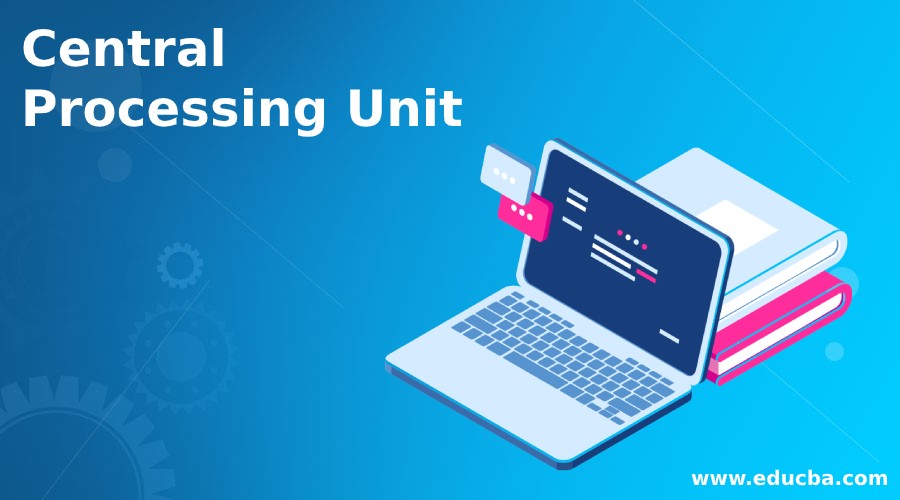Updated May 26, 2023

Introduction to Central Processing Unit
The Central Processing unit, widely known as the CPU, is the brain of a computer, and it executes program code instruction after instruction in the logical sequence it is written. It runs system software (Operating system) and application software. It takes inputs from users and other active programs, processes the data, stores intermediate results in memory, and displays the final output on the Computer screen or stores it in external memory. CPU is an electronic circuitry that performs logical, basic arithmetic, input/output, and control functions per the program flow.
History of Central Processing Unit
Given below is the history of the Central Processing Unit:
1. Custom Design CPU
During the 1940s, computers functioned through hardwiring to perform a range of tasks, devoid of software codes. One-of-a-kind computers relied on custom-designed CPUs. These machines were commonly known as fixed-program computers or stored-program computers.
2. Transistor CPU
In the 1950s and 1960s, the replacement of unreliable heavy vacuum tubes and relays took place with the emergence of smaller transistors. This enabled the integration of more sophisticated CPUs and key components onto printed circuit boards. In 1964, IBM introduced the IBM System/360, which became the first mainframe computer. IBM employed the microprogramming concept to ensure compatibility and the architecture of IBM System/360 gained significant popularity, establishing its dominance in the mainframe market for an extended period.
Transistor-based CPU had improved performance level, high reliability, lower power consumption, and achieved clock rate of 10 Mhz. IC CPUs paved the way for new processors like SIMD vector processors and facilitated the era of supercomputers from Cray and Fujitsu.
3. Large Scale Integrations
Metal oxide semiconductor field effect transistor (MOSFET) facilitated the development of large-scale integrations circuits. Very low power consumption, high scalability, and the ability to accommodate a higher density of transistors are the unique features of LSI circuits. PDP-11 computers were the first LSI implementations.
4. Microprocessors
MOS IC technology triggered the Microprocessor invention in the 1970s. Intel 4004 in 1971 and Intel 8080 in 1974 dominated all other CPU implementations. Its instruction set enabled backward compatibility with earlier hardware and software versions in mainframe computers. Microprocessors became a synonym for CPU.
Components of Central Processing Unit
Given below are the three major basic components of the Central Processing Unit:
- Arithmetic Logic Unit(ALU)
- Control Unit
- Registers
With few add-on components like Address generation units, Memory management units, and Cache.
1. Arithmetic Logic Unit
ALU is responsible for arithmetical and logical operations.
- Data(Operands): Supplied by the registers which store the result of previous operations or fresh from external memory or constant value managed internally.
- Code (Operations): Fed by the control unit as an instruction.
The results of the operation are saved in the internal register for the next operation or in the external memory via the control unit if all stages are completed, and the status registers are updated accordingly.
2. Control Unit
The component is as follows:
- Controls the operation of the CPU.
- Issues signal to ALU, memory, and I/O devices at the right time to all the units in the CPU in executing instructions.
- Moves the data from the external memory to ALU.
- Stores the output of the processing in the external memory.
3. Registers
Registers provide storage space for holding a.intermediate result, b.transit data before ALU, c process it. Output data before it is moved to external memory, d.Instructions, e.Memory address. Some registers are used for internal purposes that cannot be accessed from outside, and some are accessible to users.
Given below are the several registers:
- The instruction register brings instructions from the program counter for the Processor to execute.
- Memory buffer register.
- Memory data register.
- Memory address register.
4. Address Generation Unit
This unit computes the memory address from where the data must be fetched. This unit functions in parallel to the others and saves time for execution, and enhances performance.
5. Memory Management Unit
This unit handles the conversion of a logical address into a physical address and manages memory paging and virtual memory.
6. Cache
Frequently accessed data are stored in cache memory near the Processor as part of the CPU to avoid unwanted I/O operations and reduce processing time.
Working of Central Processing Unit
Any CPU, irrespective of its size, form, and complexity, executes a program containing instructions in a logical sequence. CPU process the first instruction and look for the next instruction in the program counter. If the next instruction is a jump statement, the corresponding instruction address where the control needs to be transferred is stored in the program counter. The program jumps to that location, and execution continues from there.
Various steps in the execution are common to most computers: fetch, decode, and execute.
1. Fetch
The program counter holds the address of the instruction, and upon processing the address, it moves to the next instruction in the logical sequence.
2. Decode
The instruction is decoded, and the kind of operation and operand on which the operation is to be performed are extracted.
3. Execute
The execute phase is carried out with the help of operation code and operand, and the results are saved in registers.
Advantages of Central Processing Unit
- CPU is the heart and brain of the computer, and it is the primary unit in the computer.
- It is small in size and fits nicely into its slot in the motherboard. It facilitates the design of small computers such as mobile phones, Tab and embedded computers, etc.
- It crunches mathematical and business data faster.
Conclusion
The continuous miniaturization of computer size enables their integration into a wide range of devices, including watches, toys, machines, and virtually all objects on Earth. CPU is an essential and critical part of the computer.
Recommended Articles
We hope that this EDUCBA information on “Central Processing Unit” was beneficial to you. You can view EDUCBA’s recommended articles for more information.


